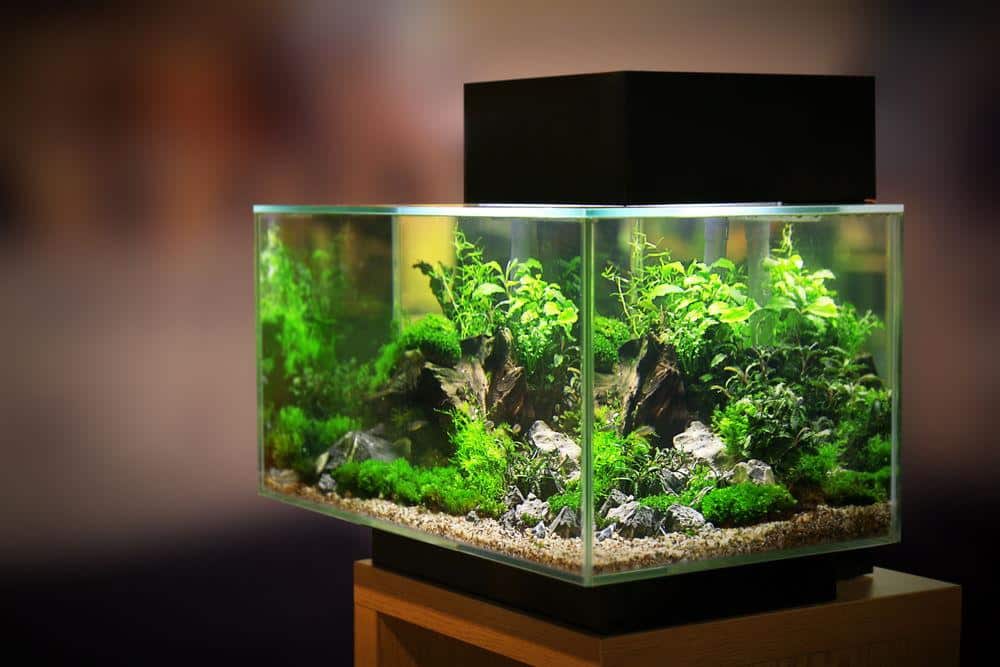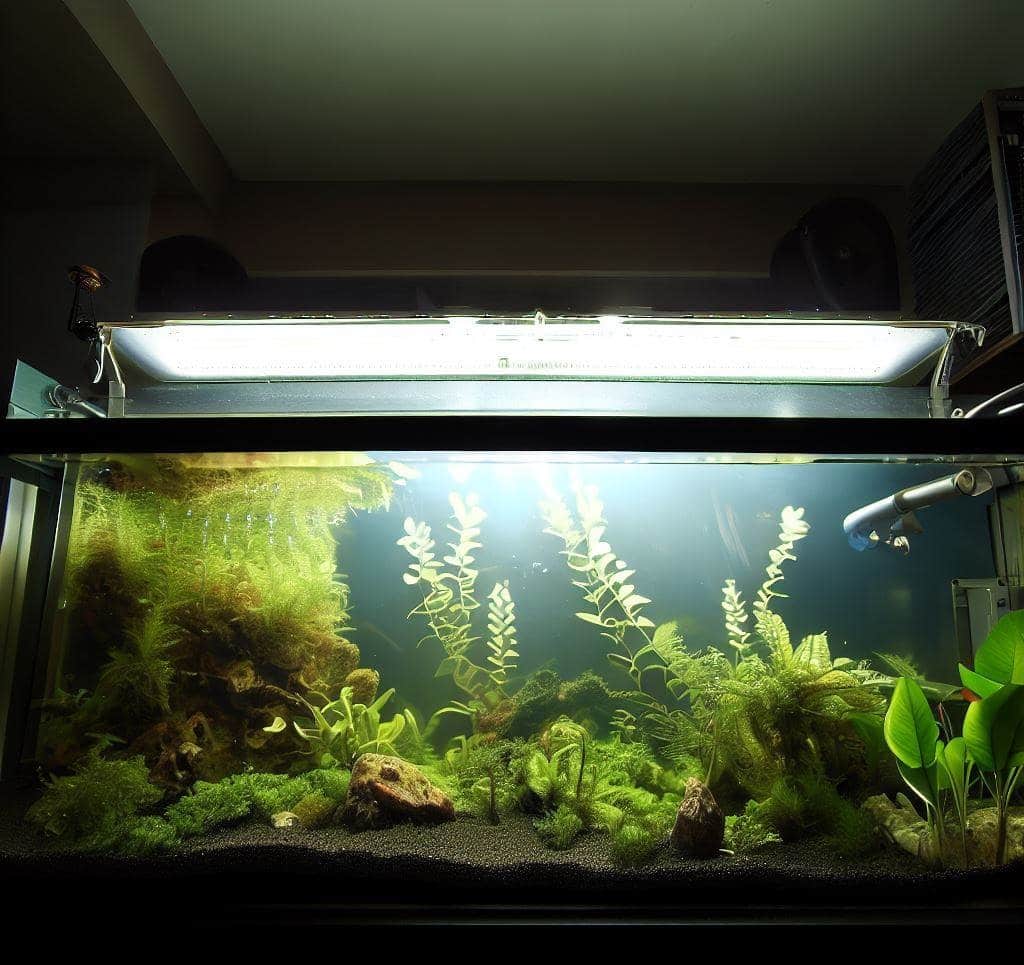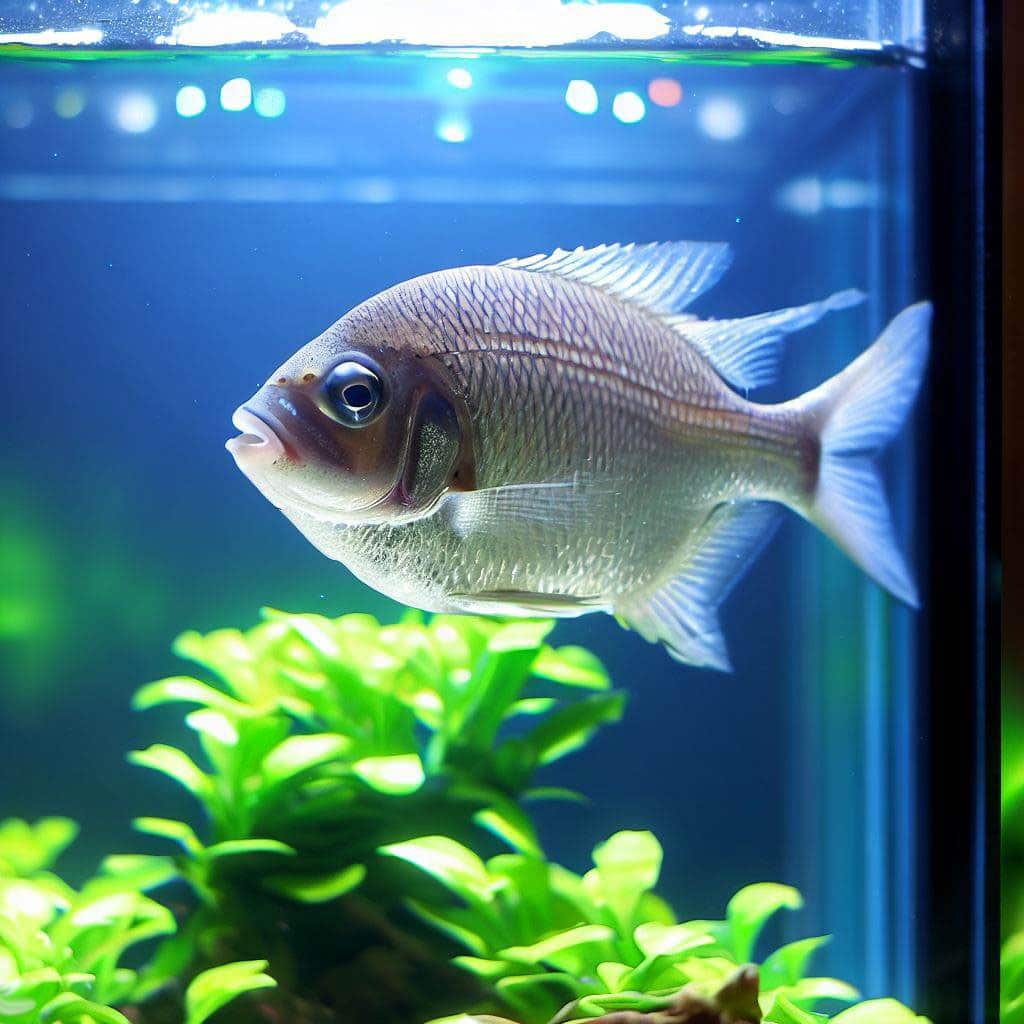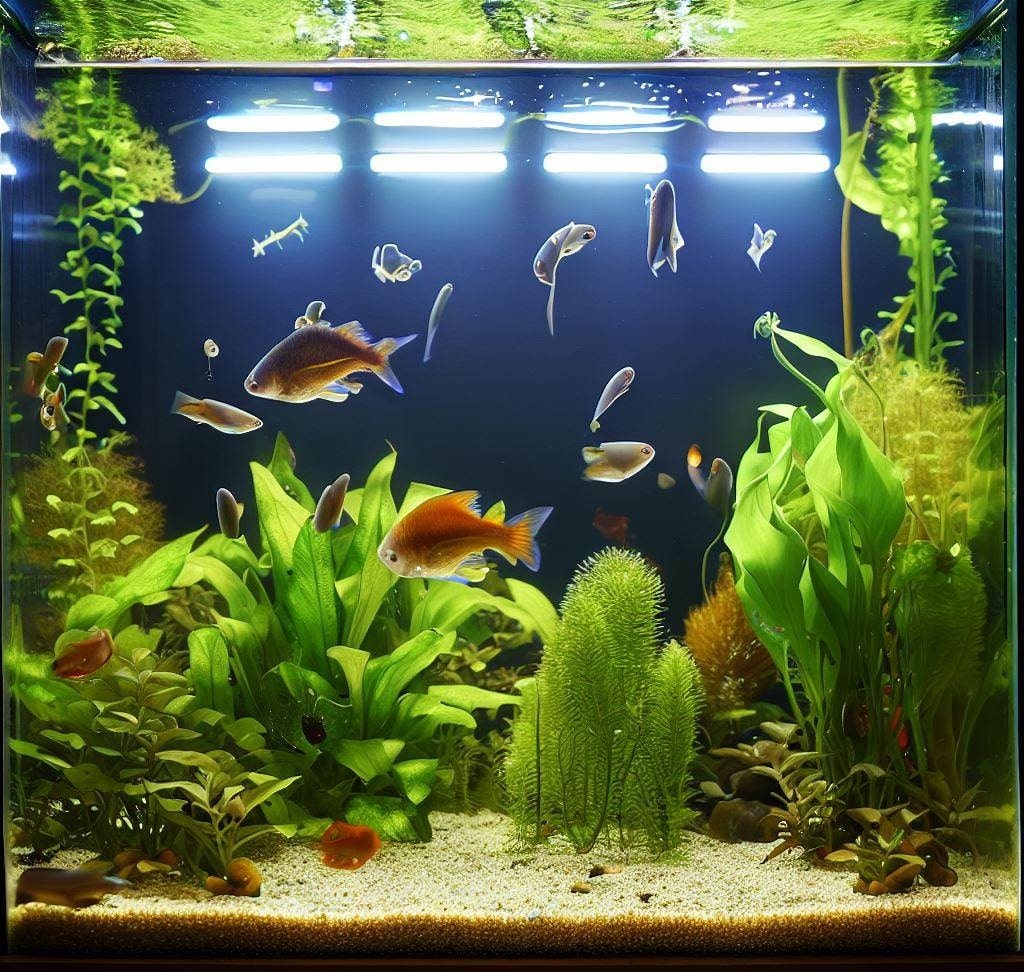What Is Planted Aquarium Lighting?
Creating an environment that simulates the beauty and balance of nature is the ultimate goal.
Table of Contents
Introduction: Planted Aquarium Lighting
For every dedicated aquarist, creating an environment that simulates the beauty and balance of nature is the ultimate goal. Just as the sun nourishes the rainforests and meadows of our planet, so does the right planted aquarium lighting breathe life into the underwater gardens of our homes. Let’s embark on a journey that illuminates the significance of lighting in a planted aquarium and unravels the intricate bond between light and photosynthesis.
The Importance of Lighting in a Planted Aquarium:
Imagine walking into a forest where the canopy is so dense that no sunlight can pierce through. The plants at the forest floor would be deprived, struggling to capture any glimmer of light. Similarly, without proper planted aquarium lighting, our aquatic plants grapple to thrive, appearing lackluster and deprived of their innate vibrancy.
Setting the Stage for Growth:
- Vitality and Color: Planted aquarium lighting not only nourishes but emphasizes the rich hues and tones of aquatic plants. For instance, the deep reds of Rotala rotundifolia or the lush green carpet of Monte Carlo can only be showcased in their full glory with the right lighting.
- Plant Health and Proliferation: Just as corals in a reef aquarium demand specific light wavelengths for growth, freshwater plants have their own unique requirements. By understanding and providing optimal planted aquarium lighting, one ensures the flourishing health of their verdant aquatic landscape.
The Dance of Light and Photosynthesis:
Photosynthesis is the silent waltz of nature, where plants, with the aid of light, produce the very oxygen we breathe and the sustenance they need.
The Power of Conversion:
- Fueling Growth: In the presence of planted aquarium lighting, plants take in carbon dioxide, absorb vital light energy, and convert it into glucose—a source of energy and growth. This process also releases oxygen, crucial for the well-being of our aquatic friends.
- The Spectrum’s Role: Different plants have varying needs when it comes to the light spectrum. For instance, the blue spectrum may encourage compact growth in some plants, while the red spectrum might promote stem elongation and flowering. Recognizing these needs is essential in choosing the right planted aquarium lighting.
Striking a Balance:
While the temptation to illuminate our aquariums extensively exists, balance is quintessential. Much like how too much sunlight can scorch terrestrial plants, excessive planted aquarium lighting can lead to issues like algae blooms.
Understanding the intricate ballet of light and photosynthesis is central to cultivating a thriving underwater garden. Aquarium lighting, when chosen and implemented correctly, can be the transformative element, turning a simple tank into a lush, thriving aquatic ecosystem. For aquarists, it’s not just about illuminating their tanks—it’s about illuminating life.

Understanding the Basics
For the passionate aquarist, the underwater realm is a canvas, and each decision, from plant selection to fish compatibility, is a brushstroke. But as in any masterpiece, lighting is paramount. In the world of aquascaping, planted aquarium lighting isn’t just about visibility—it’s the very essence that fuels growth and harmony. Let’s delve deeper into the foundational principles of lighting for a thriving planted tank.
The Science Behind It: How Plants Use Light for Photosynthesis
Every green plant you’ve ever laid eyes on, from the towering trees to the aquatic ferns in your aquarium, owes its life to photosynthesis. But how exactly does this process work?
- The Magic of Chlorophyll: Within the cells of plants lies a pigment called chlorophyll, which captures light energy. Using this energy, plants combine carbon dioxide and water to produce glucose, which provides them the energy to grow. And as a bonus for aquarists, oxygen is released in the process, a vital component for our fishy friends.
- Role of Aquarium Lighting: In an aquarium setting, the sun is out of the equation. This is where planted aquarium lighting steps in, acting as a surrogate sun, providing plants with the light energy they need to perform photosynthesis. Simply put, without appropriate lighting, plants cannot thrive, no matter how nutrient-rich the substrate or water may be.
Different Types of Aquarium Lights
In the evolving world of aquariums, there’s no one-size-fits-all lighting solution. Let’s shine a light on some popular choices.
Fluorescent Lighting:
- Overview: Once the go-to for many aquarists, these tubes offer a wide spectrum of light and are available in various sizes and wattages.
- Benefits: They’re energy-efficient and produce a pleasant, natural glow that can make your aquarium stand out.
- Best for: Tanks that require moderate lighting. Plants like Java Fern or Anubias thrive under fluorescent lights.
LED Lighting:
- Overview: LEDs, or Light Emitting Diodes, are the modern marvels of planted aquarium lighting. They’re customizable, energy-efficient, and have a long lifespan.
- Benefits: They offer adjustable color spectrums and intensities. Some even simulate natural day-night cycles.
- Best for: Both beginners and advanced aquarists. From low-light plants like Mosses to high-light ones like Dwarf Baby Tears, LEDs can cater to a wide range.
Metal Halide Lighting:
- Overview: These are intense light sources that mimic the sun’s brightness and spectrum.
- Benefits: They promote vibrant growth in plants and can penetrate deeper tanks.
- Best for: Larger, deeper aquariums or tanks with dense plant growth. Perfect for plants that demand high light.
T5 and T8 Lighting:
- Overview: These are types of fluorescent tubes, with T5 being the newer, more efficient variant.
- Benefits: They offer excellent light penetration and a broad spectrum.
- Best for: Medium to large tanks. Aquatic plants like Vallisneria or Amazon Sword can bask and grow under these lights.
Lighting Spectrum and Plants
A rainbow breaks light into its many components, and in the planted aquarium world, certain colors of this spectrum play starring roles.
Red Spectrum:
- Importance: Promotes stem growth, flowering, and fruiting in plants.
- Example: The Cabomba plant, under a red-heavy spectrum, will grow taller and might even flower.
Blue Spectrum:
- Importance: Encourages compact, bushy growth in plants.
- Example: A Dwarf Hairgrass, with a blue emphasis in its planted aquarium lighting, can spread densely, creating a lush carpet.
Green Spectrum:
- Importance: While plants reflect green (making them appear green), a balanced spectrum with green ensures the tank looks visually appealing to the human eye.
The essence of a thriving planted aquarium revolves significantly around its lighting. Understanding the role of planted aquarium lighting in photosynthesis, choosing the appropriate light type, and recognizing the spectrum’s impact can spell the difference between a lackluster tank and a thriving underwater paradise.
Factors to Consider for Optimal Aquarium Lighting
Diving into the world of aquascaping is a rewarding endeavor, but like any art form, understanding its nuances is crucial. Just as an artist considers the texture of their canvas or the blend of their paint, an aquarist must factor in several elements when selecting the perfect planted aquarium lighting. Let’s explore the variables that play an influential role in creating a thriving aquatic ecosystem.
Tank Size and Depth:
Every aquarium, from the compact nano tanks to the expansive showpieces, has its unique lighting demands.
How Tank Dimensions Affect Light Penetration and Selection:
Depth Dilemma: The deeper the tank, the more challenging it becomes for light to penetrate the bottom. For instance, a shallow 10-gallon tank might bask in the glow of a standard LED, but a deeper 50-gallon might require more intense planted aquarium lighting like Metal Halide to reach its base.
Spread and Coverage: It’s not just about intensity. Ensuring uniform light distribution is essential to avoid dark spots, especially in wider tanks. A broad tank might benefit from multiple light fixtures or LEDs with a broader spread.
Plant Types and Needs:
The diverse world of aquatic plants, each with its unique light appetite, adds another layer of consideration.
Low Light vs. High Light Plants:
Low Light Plants: These are the forgiving greens that don’t demand intense lighting. Plants like Java Moss or Anubias can flourish under moderate planted aquarium lighting, making them perfect for beginners or low-tech setups.
High Light Plants: Enter the divas of the aquatic world. Plants like the Red Ludwigia or the Glossostigma require high light levels to show their full colors and growth patterns. They might demand more advanced lighting solutions, but the visual payoff is exceptional.
Special Considerations for Carpet Plants:
Consistency is Key: Carpet plants, like Monte Carlo or Dwarf Hairgrass, aim to form a dense mat across the substrate. For an even, lush carpet, consistent and evenly spread planted aquarium lighting is crucial. Dark patches can result in patchy growth, disrupting that coveted green velvet look.
Fish Comfort and Safety:
While plants are essential, let’s not forget our finned friends who call the aquarium home.
Balancing Plant Growth and Fish Well-Being:
Avoiding the Overwhelm: While it’s tempting to blast the tank with light to promote plant growth, remember, fish aren’t fans of constant, intense light. They hail from rivers, lakes, and streams where shadows of trees and clouds often provide respite. In our pursuit of optimal planted aquarium lighting, ensuring a balanced environment that mimics their natural habitat is crucial.
Shade and Shelter: Consider adding floating plants or strategically placing decorations to provide shady areas, giving fish places to retreat and relax.
Periods of Darkness and Their Importance:
The Night’s Respite: Just as humans need sleep, fish benefit from periods of darkness. It’s not just about resting; it’s about maintaining their biological rhythms. Incorporating a consistent light-dark cycle, possibly with a timer, can ensure the fish remain stress-free and healthy.
In summary, while the quest for the perfect planted aquarium lighting is central to a lush aquatic garden, understanding and catering to the varied needs of the entire ecosystem is paramount. Whether it’s the depth of the tank, the type of plants, or the well-being of the fish, each factor intricately weaves into the tapestry of a thriving, harmonious aquarium.

Installation and Maintenance
Setting up an enchanting aquatic ecosystem is an art, and every art form has its tools. In aquascaping, one of the most vital tools is your lighting. But it isn’t just about choosing the right planted aquarium lighting; it’s also about its proper installation and maintenance. Here’s a guide to ensure you get the most out of your lights, both for your plants’ health and the visual delight of your tank.
Positioning Your Lights:
Just like a stage needs the right spotlight, your aquarium requires precision in lighting placement.
Importance of Even Light Distribution:
- The Shadow Problem: Imagine having patches of your garden in constant shade. Over time, these parts would lag in growth. Similarly, uneven lighting in your tank can lead to irregular plant growth, with some plants reaching out for light while others might get too much. Position your planted aquarium lighting such that every corner gets its share of light. For larger tanks, this might mean using multiple fixtures or opting for lights with a broader spread.
Duration of Light Exposure:
Both plants and fish thrive in a balanced environment, and light exposure plays a crucial role.
Understanding the Light Cycle for Plant Growth without Stressing Fish:
- The Golden Balance: Typically, a cycle of 6-8 hours of light can be beneficial for plant growth. But remember, extending this can lead to algae outbreaks and stressed fish. Using a timer can automate this process, ensuring your tank gets consistent light and dark periods.
- Observe and Adapt: Every tank is unique. Monitor your plants and fish. If you notice excessive algae growth, consider reducing the light duration. Conversely, if plants appear lackluster, they might need a tad more exposure. Finding the sweet spot is key.
Maintaining and Cleaning Your Lights:
Like any piece of equipment, your lights demand regular care for optimal performance.
Tips to Ensure Longevity and Optimal Performance:
- Dust and Debris: Over time, dust can settle on your light fixtures, and water splashes can leave marks. Regularly wipe down the external parts of your lights with a soft cloth to ensure clear, uninterrupted light penetration.
- Internal Check: Every few months, inspect the internal components of your lighting fixtures. Check for any signs of wear or damage, especially if you’re using fixtures with replaceable bulbs.
- Stay Safe: Before any cleaning or maintenance, always unplug your planted aquarium lighting. Safety first!
While selecting the right planted aquarium lighting is essential, its positioning, understanding of exposure duration, and regular maintenance are equally crucial. By giving attention to these details, you can ensure a dazzling, healthy aquatic environment that flourishes for years to come.
Advancements in Aquarium Lighting
Aquarium enthusiasts have been witness to an exciting era of innovation. As technology integrates more seamlessly into our lives, even our fish and aquatic plants get to benefit from the advancements. Especially when it comes to planted aquarium lighting, we’ve leaped miles from the rudimentary bulbs of the past. Dive in to discover the contemporary marvels reshaping the way we light our underwater worlds.
Smart Lighting Systems:
Gone are the days of manually switching on and off your aquarium lights or struggling with separate timers. Welcome to the age of intelligent lighting!
Programmable Systems and Their Benefits:
- Customized Lighting Schedules: Smart planted aquarium lighting systems offer you the flexibility to set precise lighting schedules. Whether you’re simulating a dawn-to-dusk natural light cycle or mimicking the cloudy overcasts of the Amazon, it’s all just a few taps away.
- Intensity and Spectrum Control: These systems aren’t just about on-and-off schedules. Advanced models allow aquarists to adjust light intensity and even color spectrum, enabling optimal conditions for both flora and fauna.
- Remote Access: Heading out on a vacation? Modern lighting systems often come with apps, allowing you to control your planted aquarium lighting remotely. Unexpected changes? Adjust lighting conditions from the beach or your hotel room with ease!
Energy Efficiency and Sustainability:
As environmental consciousness grows, it’s heartening to see the world of aquascaping riding the green wave.
Eco-friendly Options and Long-Term Cost Savings:
- LEDs Lead the Way: With their low power consumption and longer lifespan, LEDs have become the torchbearers for sustainable planted aquarium lighting. For instance, while a traditional fluorescent might last around 8,000 hours, LEDs often surpass 50,000 hours. Over time, this translates to fewer bulb replacements and tangible energy savings.
- Cooler and Kinder: Traditional lighting solutions tend to produce more heat, potentially impacting tank temperature. LEDs, known for their cool operation, are gentler on both the environment and your aquatic inhabitants.
- Initial Investment vs. Long-Term Savings: While eco-friendly lighting options might seem pricier at first glance, the long-term energy savings and reduced replacement costs make them a smart investment for both your pocket and the planet.
It’s an exhilarating time to be an aquarist. As technology propels us forward, it’s heartening to know that even in the niche world of planted aquarium lighting, we aren’t just making strides; we’re making leaps. And in doing so, we’re ensuring brighter, smarter, and more sustainable futures for our aquatic companions.
Common Mistakes in Planted Aquarium Lighting
Navigating the waters of aquascaping can be as intricate as sailing the vast oceans. One pivotal aspect where many enthusiasts often falter is planted aquarium lighting. Striking the right balance is key, and veering too much in either direction can have significant repercussions. Let’s dive into two frequent pitfalls and how you can sidestep them.
Over-lighting and Algae Growth:
While we all want our aquatic plants to bask in light and flourish, there’s such a thing as too much of a good thing when it comes to lighting.
The Correlation Between Excessive Light and Algae Proliferation:
- Algae Blooms: Imagine if someone left the curtains of your room open during the peak of summer all day, every day. Overexposure would become a discomfort. Similarly, too much light in your aquarium can induce rapid and unwanted algae growth. The green, murky waters aren’t just an eyesore but compete with plants for essential nutrients.
- Why It Happens: In environments with excessive light, especially when combined with abundant nutrients, algae can grow exponentially. This is nature’s way of balancing things out. If your planted aquarium lighting is more than your plants can use for photosynthesis, algae happily take up the excess.
- Solution: Monitoring is key. Begin with a standard 6-8 hour lighting period and adjust based on observation. Employing a timer can automate the process, preventing any accidental overexposure.
Under-lighting and Stunted Plant Growth:
On the flip side, insufficient light can spell doom for your verdant underwater garden.
Signs Your Plants Aren’t Getting Enough Light and Solutions:
- Stretching and Elongation: One classic sign of light deprivation is when your plants stretch out or grow taller than usual, reaching for the light source. Leaves might also grow larger than typical to maximize light absorption.
- Pale and Yellowish Leaves: Insufficient light can lead to a loss of vibrant green color, leaving plants pale or even yellowish.
- Solutions: If you suspect your plants are under-lit, consider increasing the duration of your planted aquarium lighting before investing in brighter lights. If the problem persists, explore lighting solutions with higher lumens or better spectrum coverage.
Lighting in aquascaping is a delicate dance of shadows and illumination. By being observant and proactive, you can ensure your aquatic garden thrives while keeping unwanted algae at bay. Remember, with planted aquarium lighting, it’s all about balance and adaptation.

FAQs: What we’ve been asked
The world of aquascaping is as vast as it’s captivating. One realm that’s often riddled with questions pertains to planted aquarium lighting. Whether you’re a newbie setting up your first aquarium or an enthusiast looking to dive deeper, these FAQs shed light (pun intended!) on this pivotal subject.
1. Why is lighting so crucial for a planted aquarium?
Lighting plays an essential role in the photosynthesis process, where plants convert light and carbon dioxide into oxygen and energy. Without adequate lighting, plants can’t generate the energy needed to grow, leading to stunted growth or even plant death.
2. How many hours a day should I keep my aquarium lights on?
Typically, the recommended duration for planted aquarium lighting is between 6 to 8 hours a day. However, this can vary based on the type of plants you have and their specific light requirements. Monitoring plant health and growth will help you fine-tune the duration.
3. Are LED lights suitable for planted aquariums?
Absolutely! LED lights have surged in popularity due to their energy efficiency and longevity. Their capability to emit a wide range of color spectrums makes them ideal for simulating natural sunlight conditions vital for aquatic plants.
4. How do I know if I’m over-lighting my aquarium?
Over-lighting can lead to a rapid growth of algae, turning your aquarium water murky green. Additionally, plants might exhibit signs like leaf burns or unusual coloration. Regularly checking your aquarium for these signs and adjusting your planted aquarium lighting accordingly can prevent such issues.
5. Can the wrong lighting harm my fish?
Yes, it can. Fish are sensitive to their environment. Too much light can stress them, disrupt their sleep cycles, and even encourage aggressive behavior. Ensuring a balanced light cycle and periods of darkness can keep your finned friends happy.
6. Do all plants require the same amount of light in an aquarium?
No, different plants have varying light requirements. While some aquatic plants thrive in high light conditions, others prefer low to medium light. It’s essential to research each plant’s needs when setting up your planted aquarium lighting.
7. How often should I replace my planted aquarium lighting?
While LEDs can last up to 50,000 hours, traditional fluorescent bulbs have a shorter lifespan, around 8,000 hours. It’s wise to replace or check your lights annually to ensure they’re providing the optimal spectrum and intensity for your aquatic plants.
8. Can I use regular bulbs instead of aquarium-specific lights?
While regular bulbs can illuminate your aquarium, they may not provide the correct spectrum required for plant growth. Aquarium-specific lights are tailored to simulate natural sunlight conditions, making them far superior for a thriving aquatic environment.
9. Why is the color spectrum important for planted aquarium lighting?
Different plants use different parts of the light spectrum for photosynthesis. For instance, red and blue spectrums play pivotal roles in plant growth and health. Ensuring your lights provide a broad spectrum ensures your plants get the light nourishment they need.
10. How do I manage algae growth related to lighting issues?
Over-lighting is a common cause for excessive algae growth. To combat this:
- Adjust Lighting Duration: Reduce the number of hours your light is on.
- Balance Nutrients: Excess nutrients combined with over-lighting can exacerbate algae growth. Monitor nutrient levels and make adjustments as needed.
- Introduce Algae Eaters: Certain fish and snails feed on algae, helping to naturally control its growth.
While the realm of effective aquarium lighting might seem complex, understanding the basics and making informed decisions can lead to a vibrant and thriving aquatic haven. Always remember, nature thrives on balance, and it’s up to you to strike that harmony in your aquatic world.
Conclusion: Final Note on Planted Aquarium Lighting
The Harmony of Light in Fostering Both Plant Growth and Fish Health
At the heart of a thriving aquatic ecosystem lies the delicate dance of light. It’s the lifeblood of your plants, enabling them to perform photosynthesis, and the comfort blanket for your fish, setting their internal rhythms. Aquarium lighting plays an indispensable role in creating an environment where both plants and fish can flourish side by side.
Consider, for instance, the lush Amazon riverbeds. They are naturally illuminated by sunlight filtered through dense canopies, providing pockets of shade and light – a template we aim to replicate with our artificial lighting systems. This natural ambiance not only fosters growth but also ensures a haven for the aquatic life dwelling beneath.
Emphasizing the Importance of Regular Monitoring and Adjustments
Every aquarium is unique, and what works for one might not necessarily be a blueprint for another. While setting up aquarium lighting provides the initial foundation, the real magic lies in regular monitoring and adjustments.
Take the example of a plant that’s grown too tall, shadowing the plants beneath. This could result in those overshadowed plants not receiving enough light, stunting their growth or causing them to wilt. Similarly, noticing your fish hiding or showing signs of stress could be an indicator that your lighting might be too intense.
By keeping a keen eye on both plant and fish behavior, and adjusting the intensity or duration of your aquarium lighting, you can fine-tune the environment to achieve that perfect balance.
In closing, diving into the world of aquascaping with a well-researched approach to lighting can make all the difference. Remember, it’s not just about aesthetics; it’s about creating a holistic, balanced, and thriving ecosystem. Whether you’re a novice or a seasoned aquarist, let the guiding principle behind your planted aquarium lighting choices be the natural rhythm and needs of the life it nurtures.






